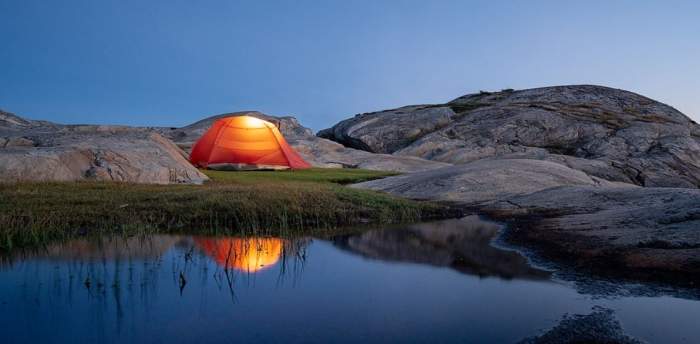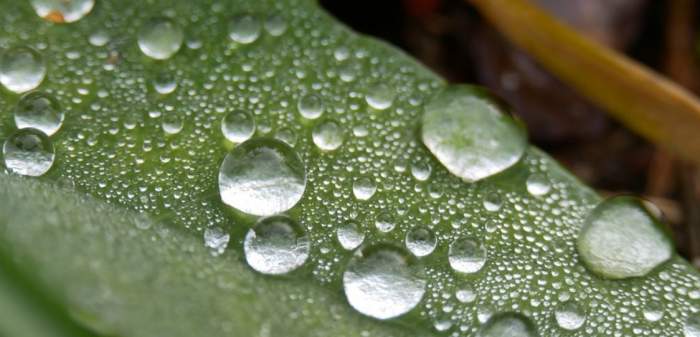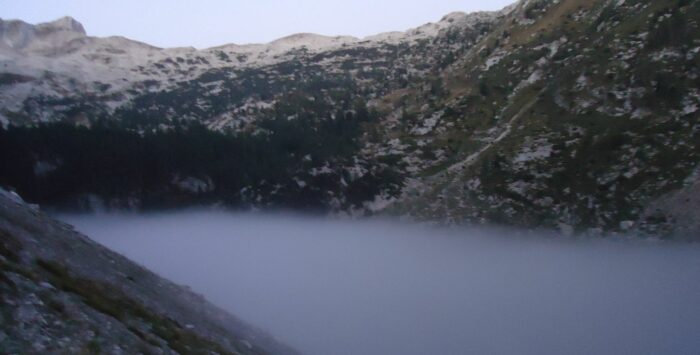You can have plenty of moisture in a tent that is fully waterproof and non-leaking. So why is the tent wet inside? The reasons are both internal and external, keep reading.

Here are some of the most frequent reasons for moisture in the tent:
- General high air humidity.
- Breathing of users.
- Wet items in the tent.
- Cooking in the tent.
- Poor ventilation.
- A few more like tent’s door orientation with respect to wind, vicinity of larger water areas like in the picture above, etc.
There are probably more reasons but those mentioned above are the first that come to mind.
General high air humidity affects moisture in the tent
Regarding the air humidity, I have seen once a review of a tent where the author was unpleasantly surprised with the amount of water on the floor in the morning. She concluded that the tent was leaking although the rain during the night was less than mild.
But she mentioned just by chance that air humidity was very high and she was camping in fog. So in my view this explained it, and I mentioned this in the comment under her video.
Humidity is the amount of water vapor in the air. It is dependent on temperature, so for example, at 14 F (-10 C) the air can contain up to around 2.2 grams of water per a cubic meter, and this maximum amount is its 100 percent humidity.
This is not much but this is all temperature dependent. At 68 F (20 C) the maximum is 17 g/m³, at 86 F (30 C) you can have up to 30 g/m³, so you get the idea.
In the case of pressure and temperature variations during the night, the air can become oversaturated, and this can lead to sudden condensation of vapor on the items in the tent. This water created by condensation will eventually collect on the floor, and if it was also raining outside, you could wrongly conclude that the tent was leaking.

Breathing in the tent – How much water do we exhale per day?
So this is a factor which you cannot do anything about, we have to breathe. There are various sources that give numbers, and they all differ a bit, but it is a fact that we exhale vapor. In a reliable source, you can read that this is temperature dependent, and this also depends on our activity.
So if you have 95 F (35 C) and 75% humidity, there can be around 7 ml/h of water created when you breathe. When the temperature is 14 F (-10 C) and 25% humidity, you can have up to 20 ml/h. Some even speak about 40 ml/h. When you sleep, less vapor is produced than when you just sit in the tent.
Now if you have 3 people in a tent, for the mentioned temperatures you can get anywhere between 20 and 120 ml/h. Now multiply this by 6 or 8, which is the number of hours during the sleep, and you get plenty of water in the tent even if the tent is not leaking.
Wet items in the tent increase moisture
If the tent is your only shelter, no car nearby, and it is raining, then you have to keep your gear and clothing inside. If you have walked in the rain, then everything is dump and wet. As it dries out, the moisture will collect on the tent’s fabric, and this will add to the overall moisture in the tent.
I have experienced this many times in the mountains. The problem is the same when you sleep in the car, you still have to keep your things in the car if it is raining, so lots of condensation will be there during the night. There is not much you can do about this. I just try to keep a bit of ventilation, this definitely helps.
Cooking in the tent increases vapor
In my another text I already discussed cooking in the tent, so this is usually with a gas heater or a wood burning tent stove.
In both cases you will have moisture from the meal and cooking, but gas burners produce vapor as well.
Poor ventilation prevents vapor from escaping
If you have nicely designed tent vents, a part of the vapor will be able to escape and this will reduce condensation. You can follow the link and read more. Sometimes you will see full-coverage fly tents without vents, and this is a recipe for lots of condensation underneath the fly.
Here are a few more details from Vango, many of their tents are presented here in the site, please have a look:
Do not camp too close to large water areas
You will also see frequently advised to avoid pitching the tent close to larger water areas, and I mentioned this above. This is a good advise, and you can realize this perhaps from the photo below.
This is my early tour in the Alps, this is why the light is so bad and the photo is not sharp. But what you see is the fog created and sitting directly above a mountain lake.

I was back the same way, and can tell you there were nice places around the lake to pitch a tent. But having a tent there would mean being immersed in a thick fog all the night. Just a few tens of meters higher the air was completely dry, but little space to put a tent.
So it is very easy to make such a mistake, and it is important to repeat this warning, it makes sense.
Related to all this is the condensation that you see on the underside of the tent’s shell. This is because of the cold fabric and warmer vapor inside the tent. This temperature difference leads to condensation, but the real reason for water created in the tent is the vapor that is already in the inner air due to any of the reasons mentioned above.
All in all, if you have ever asked yourself why your tent was wet inside, you can be sure that some of the reasons mentioned above are behind it. But the tent can also be leaking of course. See a bit more in my separate text about waterproof rating for tents.
You might want to read also my another detailed text about temperature differences in winter tents. Thank you for reading and have a nice day.
Thank you for this article. I’ve never been able to really love camping because of waking up in the morning to find everything damp with condensation just as you talked about in your article. Most of the camping I’ve done has been in the summer, in hot and humid conditions, and almost always rain of varying degrees. Do you have any specific tent brand suggestions for combating condensation in the above scenario? Many thanks in advance.
Hi Nicole.
You are right and it is indeed how you describe it. It will be similar even if this is not about humid conditions, this is because we exhale moisture.
It is essential that the tent has vents on the fly. I always point out ventilation in my texts. It is even better if there are floor vents as well, they add to the air circulation a lot. I can suggest many tents with such features if you tell me the size and shape of the tent you want.
Yet another option is to sleep off the ground. This reduces the usual damp that comes from the ground. This would mean using a cot-tent, so you sleep on a cot which has a tent attached to it.
Another option is sleeping on the roof of the car. There are surprisingly great roof top tents on the market.